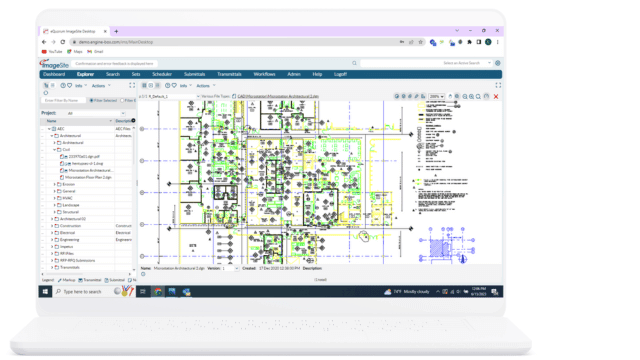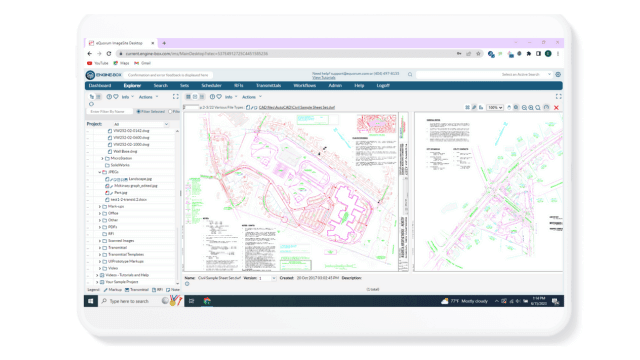Promoting Effective Communication and Improved Collaboration
Promoting Effective Communication and Improved Collaboration
In the world of architecture and construction, building and promoting effective communication can be challenging, especially when it comes to project management. The AEC (architecture, engineering, and construction) industry consists of employees with different roles, education backgrounds, and communication styles, who tend to struggle with collaboration. The miscommunication brought on by these differences often creates confusion and friction between workers that can cause errors and unnecessary project delays.

Third-Party Collaboration
With 3P Direct organizations can provide third parties access for viewing, downloading, marking up, and printing of documents, including CAD drawings and get feedback directly inside the product without having to setup the user or any VPNs.
Why is communication so difficult?
Communication typically works best amongst those who share common beliefs and opinions, and while all project members work together to achieve a common goal, workers with varying roles may express differences in the way they think, speak, and solve problems. For example, architects often have excellent visualization abilities, but may lack the ability to successfully communicate their ideas to customers or other members of their team. Even when architects and engineers work closely with one another to conceptualize a design, they may still struggle to effectively communicate specific details to downstream contractors. All the same, there’s no doubt collaboration is always critical to the success of a project.
Miscommunication can happen through all stages of a project but often presents the most challenges as the project progresses to its latter half. A misinterpretation on behalf of vendors and contractors can lead to costly mistakes that can push back deadlines and leave customers dissatisfied. Keep reading to discover EDMS solutions that make promoting effective communication and improved communication easier.
Like other written forms of communication, RFIs provide managers with insights into who requested the information, the engineers assigned to a project, and the request description. They also provide key information regarding the schedule or cost impact it has on the project, which can be beneficial for managers who need to propose changes in the budget or project deadline.

Engineering RFIs/Submittals
Easily collaborate by providing users with a quick and organized way to handle information requests and submissions. Efficiently communicate with downstream contractors, vendors, and customers without needing to provide them access to information not relevant to their job functions.
How to efficiently communicate with downstream parties
Many organizations realized these issues early on, which is why construction companies created the RFI. An RFI (Request For Information) is a formal procedure used by designers and downstream contractors to fill gaps in information needed for the successful completion of a project. It’s typically submitted as a standardized form that seeks the clarification of plans, drawings, and specifications, allowing engineers and contractors to collaborate over projects while keeping continuous records of the changes and clarifications made.
With that being said, most architects and engineers don’t get everything right the first time, yet, this doesn’t mean they’re bad at their job. People often make mistakes and/or neglect information, which is why the RFI exists in the first place. Nevertheless, RFIs are a great way to increase the accountability of project members, as this information can be archived for subsequent review and analysis.
Seamlessly communicate changes and express ideas in a unified environment
Managing workflows is also a common challenge for many firms, as they typically consist of complex approval processes, with step actions governed by specific conditions. Electronic document management systems make it easy to manage both simple and complex workflows by automating what would usually be menial and time-consuming tasks. Additionally, engineering workflow promotes communication and collaboration by displaying project information in a single digital location that’s accessible on any device regardless of location. Put simply, it takes meaningless, repetitive tasks out of the equation, so workers can focus on what’s important – communication.
While workflows and RFIs are great tools for improving and promoting effective communication, nothing helps more than the workflow and document management system itself. Hosting files in a single location enables relevant employees to markup and comment on drawings and documents quickly and easily. Unlike traditional file management systems, workers can use the systems robust search tool to find files and documents instantly, significantly reducing the amount of time required to share documents.

Engineering Workflow
Automatically manage and distribute files and documents for review, approval, and processing. Adjust user permissions at each step, ensuring your company’s files are managed securely.
Additional EDMS Features
Our EDMS solutions
ImageSite and EngineBox are eQuorum’s robust workflow and document management solutions, created to help workers manage their essential workflows while maintaining complete control over their engineering files and documents. Not only do they provide a secure collaboration site for workers, but they also help organizations manage document distribution with third parties like vendors, contractors, and customers. Both systems are offered at a competitive price, enabling organizations to get a quick return on their investment by providing the features and functionality needed to help organizations improve efficiency, productivity, and collaboration. Companies can choose from concurrent user subscriptions or named user subscriptions, ensuring organizations have subscription options that make sense for their business.

ImageSite®
Our single source engineering workflow and document management system. Built in HTML5 so there is no software to deploy to client computers or mobile apps to download. Offered as an On-premise or Private Cloud system.
EngineBox™
EngineBox is a cloud based workflow and document management version of ImageSite that resides outside the corporate network.
Our EDMS solutions
ImageSite and EngineBox are eQuorum’s robust workflow and document management solutions, created to help workers manage their essential workflows while maintaining complete control over their engineering files and documents. Not only do they provide a secure collaboration site for workers, but they also help organizations manage document distribution with third parties like vendors, contractors, and customers. Both systems are offered at a competitive price, enabling organizations to get a quick return on their investment by providing the features and functionality needed to help organizations improve efficiency, productivity, and collaboration. Companies can choose from concurrent user subscriptions or named user subscriptions, ensuring organizations have subscription options that make sense for their business.

EngineBox™
EngineBox is a cloud based workflow and document management version of ImageSite that resides outside the corporate network.
The eQuorum Customer Promise
In 2005, eQuorum developed the first all browser-based EDMS. The system, although for on-premise use, was still created to remove client software and JAVA from user computers and allow users to have a single viewer based on the simple navigation functionality of browsers. Today, eQuorum provides that same application in a private Cloud or a SaaS Cloud option. We can do this because we are, and have always been, browser-based, understanding the enhanced speed, security, and usability of this technology.
With the abundance of document management systems on the market today, there’s no doubt that choosing the right Cloud document management software can be a difficult decision. eQuorum is here to provide a comprehensive, powerful, and most importantly – affordable Cloud document management solution. We believe in providing real value to our customers by eliminating unnecessary costs, providing industry-leading functionality, and equipping your team with the right tools using cutting edge technology to bring your products to market faster.
eQuorum®
We specialize in engineering workflow and document management. Our comprehensive, yet easy-to-use software provides the solution to manage data from design to manufacturing and production, to sales, support and administration.